Intro
Identify 5 DVT symptoms, including swelling, pain, and discoloration, to recognize deep vein thrombosis signs, risks, and prevention methods, and learn about blood clots, thrombosis treatment, and pulmonary embolism causes.
Deep vein thrombosis, commonly referred to as DVT, is a serious medical condition that occurs when a blood clot forms in a deep vein, typically in the legs. This condition can be life-threatening if the clot breaks loose and travels to the lungs, causing a pulmonary embolism. It is essential to recognize the symptoms of DVT to seek medical attention promptly. The importance of early detection and treatment cannot be overstated, as it significantly improves outcomes and reduces the risk of complications. Understanding the signs and symptoms of DVT is crucial for individuals at risk, such as those with a family history, smokers, and people who are overweight or lead a sedentary lifestyle.
DVT symptoms can vary from person to person, and some individuals may not exhibit any noticeable signs until the condition has progressed. However, being aware of the common symptoms can help individuals take preventive measures and seek medical help if they suspect they have DVT. The symptoms can range from mild to severe and may include swelling, pain, and discoloration of the affected limb. Recognizing these symptoms early on can make a significant difference in the effectiveness of treatment and the prevention of long-term damage.
The risk factors associated with DVT are numerous, including age, obesity, smoking, and a family history of blood clots. Individuals with these risk factors should be particularly vigilant about monitoring their health and seeking medical attention if they notice any unusual symptoms. Furthermore, people who have recently undergone surgery, are immobile for extended periods, or have cancer are also at a higher risk of developing DVT. By understanding these risk factors and being aware of the symptoms, individuals can take proactive steps to reduce their risk and ensure prompt treatment if DVT occurs.
DVT Symptoms Overview
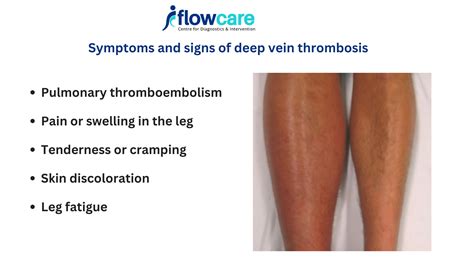
The symptoms of DVT can be subtle and may not always be immediately apparent. However, common signs include swelling, redness, and warmth of the affected limb. Pain or tenderness in the leg, which may feel like a cramp, is also a prevalent symptom. In some cases, the skin may become discolored, turning a bluish or pale color. It is essential to note that some individuals may not experience any symptoms at all, making regular check-ups with a healthcare provider crucial for those at risk.
Common DVT Symptoms
Some of the most common symptoms of DVT include: - Swelling of the leg or arm - Pain or tenderness in the leg, which may feel like a cramp - Redness or discoloration of the skin - Warmth or inflammation of the affected limb - Weakness or fatigue in the leg - Low-grade feverUnderstanding DVT

DVT occurs when a blood clot forms in a deep vein, typically in the legs. This clot can be caused by a variety of factors, including injury to the vein, immobility, and genetic conditions that affect blood clotting. The clot can block blood flow, leading to swelling, pain, and other symptoms. If the clot breaks loose, it can travel to the lungs, causing a pulmonary embolism, which is a life-threatening condition.
Risk Factors for DVT
Several risk factors increase the likelihood of developing DVT, including: - Age: The risk of DVT increases with age - Obesity: Being overweight or obese increases the risk of DVT - Smoking: Smoking damages the lining of blood vessels, increasing the risk of clot formation - Family history: A family history of blood clots increases the risk of DVT - Recent surgery: Surgery, especially on the hips or knees, can increase the risk of DVT - Immobility: Prolonged periods of immobility, such as during long flights or bed rest, can increase the risk of DVTDVT Prevention
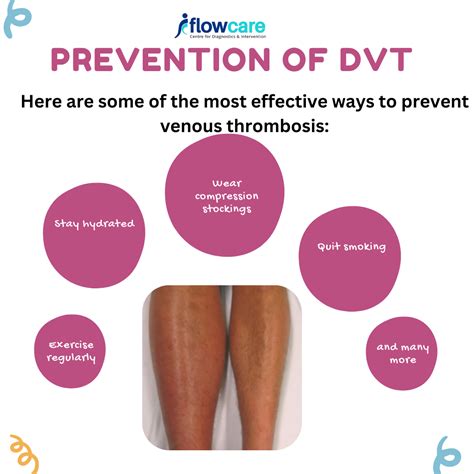
Preventing DVT involves reducing the risk factors associated with the condition. This can include maintaining a healthy weight, quitting smoking, and engaging in regular physical activity. Individuals at risk should also consider wearing compression stockings, especially during long periods of immobility, and staying hydrated by drinking plenty of water. Regular check-ups with a healthcare provider can also help identify any potential issues early on.
Lifestyle Changes to Prevent DVT
Lifestyle changes can play a significant role in preventing DVT, including: - Maintaining a healthy weight through diet and exercise - Quitting smoking to reduce damage to blood vessels - Engaging in regular physical activity to improve circulation - Wearing compression stockings during long periods of immobility - Staying hydrated by drinking plenty of waterDVT Treatment
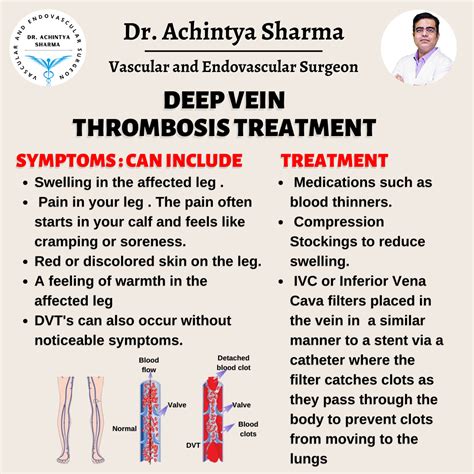
Treatment for DVT typically involves anticoagulant medications to prevent the clot from growing and to reduce the risk of another clot forming. In some cases, thrombolytic medications may be used to dissolve the clot. Compression stockings can also help reduce swelling and improve circulation. In severe cases, surgery may be necessary to remove the clot.
Medications for DVT
Medications play a crucial role in the treatment of DVT, including: - Anticoagulants to prevent the clot from growing and to reduce the risk of another clot forming - Thrombolytics to dissolve the clot - Antiplatelet agents to prevent platelets from clumping together and forming another clotDVT Complications
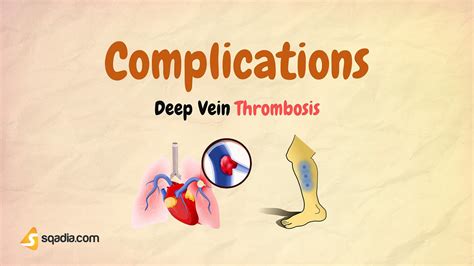
If left untreated, DVT can lead to serious complications, including pulmonary embolism, post-thrombotic syndrome, and recurrent DVT. Pulmonary embolism occurs when the clot breaks loose and travels to the lungs, causing a blockage in one of the arteries. Post-thrombotic syndrome is a condition characterized by chronic pain, swelling, and discoloration of the affected limb. Recurrent DVT increases the risk of long-term damage to the veins and the risk of another pulmonary embolism.
Long-term Effects of DVT
The long-term effects of DVT can be significant, including: - Chronic pain and swelling in the affected limb - Discoloration and skin changes - Increased risk of recurrent DVT and pulmonary embolism - Damage to the valves in the veins, leading to chronic venous insufficiencyDVT Diagnosis
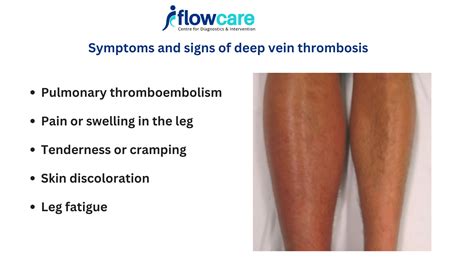
Diagnosing DVT typically involves a combination of physical examination, medical history, and imaging tests. The healthcare provider will look for signs of swelling, redness, and warmth in the affected limb. Imaging tests, such as ultrasound, CT scan, or MRI, can help confirm the presence of a clot.
Imaging Tests for DVT
Imaging tests play a crucial role in diagnosing DVT, including: - Ultrasound to create images of the veins and detect blood flow - CT scan to create detailed images of the veins and detect clots - MRI to create detailed images of the veins and detect clotsLiving with DVT

Living with DVT requires ongoing management and monitoring to reduce the risk of complications and improve quality of life. This can include taking anticoagulant medications as directed, wearing compression stockings, and engaging in regular physical activity. It is also essential to attend follow-up appointments with the healthcare provider to monitor the condition and adjust treatment as necessary.
Coping with DVT
Coping with DVT can be challenging, but there are several strategies that can help, including: - Taking anticoagulant medications as directed - Wearing compression stockings to reduce swelling - Engaging in regular physical activity to improve circulation - Attending follow-up appointments with the healthcare provider to monitor the conditionWhat are the common symptoms of DVT?
+The common symptoms of DVT include swelling, pain, redness, and warmth of the affected limb. Some individuals may also experience weakness or fatigue in the leg, and low-grade fever.
How is DVT diagnosed?
+DVT is typically diagnosed through a combination of physical examination, medical history, and imaging tests, such as ultrasound, CT scan, or MRI.
What are the risk factors for DVT?
+The risk factors for DVT include age, obesity, smoking, family history, recent surgery, and immobility. Individuals with these risk factors should be particularly vigilant about monitoring their health and seeking medical attention if they suspect they have DVT.
How is DVT treated?
+DVT is typically treated with anticoagulant medications to prevent the clot from growing and to reduce the risk of another clot forming. In some cases, thrombolytic medications may be used to dissolve the clot.
Can DVT be prevented?
+Yes, DVT can be prevented by reducing the risk factors associated with the condition. This can include maintaining a healthy weight, quitting smoking, engaging in regular physical activity, wearing compression stockings, and staying hydrated.
In conclusion, DVT is a serious medical condition that requires prompt attention and treatment. By understanding the symptoms, risk factors, and treatment options, individuals can take proactive steps to reduce their risk and improve their outcomes. If you suspect you have DVT, it is essential to seek medical attention immediately. Remember, early detection and treatment are critical in preventing long-term damage and reducing the risk of complications. We encourage you to share this article with others, especially those at risk, and to comment below with any questions or concerns you may have. Together, we can raise awareness about DVT and promote a healthier, more informed community.
